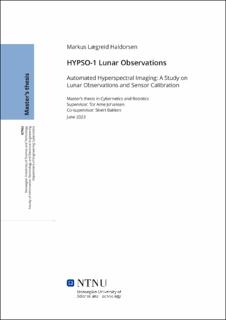| dc.contributor.advisor | Johansen, Tor Arne | |
| dc.contributor.advisor | Bakken, Sivert | |
| dc.contributor.author | Haldorsen, Markus Lægreid | |
| dc.date.accessioned | 2023-11-02T18:20:06Z | |
| dc.date.available | 2023-11-02T18:20:06Z | |
| dc.date.issued | 2023 | |
| dc.identifier | no.ntnu:inspera:140443607:100758582 | |
| dc.identifier.uri | https://hdl.handle.net/11250/3100358 | |
| dc.description.abstract | Betydningen av nøyaktig hyperspektral bildebehandling i fjernmåling har ført til behovet for forbedrede kalibreringsteknikker. Denne avhandlingen undersøker automatisering av måneobservasjoner som en metode for kalibrering av hyperspektrale bildesensorer, spesifikt ombord på HYPSO-1-satellitten. Studien forsøker å svare på hvordan hyperspektral bildebehandling kan brukes til å fange og analysere fullmånefaser, de tekniske utfordringene med å automatisere månefangst, og hvordan funnene kan brukes til andre applikasjoner eller systemer.
Metodikken involverte utvikling og implementering av algoritmer og modeller for å automatisere måneobservasjonsprosessen, og skape et system som minimerer behovet for manuell intervensjon. Python og Systems Tool Kit var de primære verktøyene som ble brukt for å utvikle og teste løsningen.
Arbeidet resulterte i en strømlinjeformet prosess for å fange månedata med HYPSO-1-satellitten. Selv om det var vellykkede fangster, opplevde prosessen også noen feil, noe som gir et balansert syn på ytelsen og områdene for forbedring.
Denne forskningen tilbyr en forbedret prosess for måneobservasjoner og sensor kalibrering. Den bidrar til automatiseringen av måneobservasjonsprosessen, og tilbyr potensielle fordeler i form av operasjonell effektivitet og nøyaktighet. Selv om fokuset er på HYPSO-1-satellitten, kan funnene ha bredere implikasjoner for andre planetobservasjonsoppdrag eller små satellittoppdrag. Den fremhever også områder for fremtidig forskning, i raffinering av tilnærmingen og utvidelse til forskjellige kontekster. | |
| dc.description.abstract | The importance of accurate hyperspectral imaging in remote sensing has given rise to the necessity of enhanced calibration techniques. This thesis investigates the automation of lunar observations as a method for calibrating hyperspectral imaging sensors, specifically onboard the HYPSO-1 satellite. The study attempts to answer how hyperspectral imaging can be used to capture and analyze the full moon phases, the technical challenges in automating moon captures, and how the findings can be applied to other applications or systems.
The methodology involved developing and implementing algorithms and models to automate the lunar observation process, creating a system that minimizes the need for manual intervention. Python and Systems Tool Kit were the primary tools used for developing and testing the solution.
The work resulted in a streamlined process for capturing lunar data with the HYPSO-1 satellite. While there were successful captures, the process also faced some failures, providing a balanced view of the performance and the areas for improvement.
This research offers an improved process for lunar observations and sensor calibration. It contributes a step towards automating the lunar observation process, offering potential benefits in terms of operational efficiency and accuracy. While its focus is the HYPSO-1 satellite, the findings could have broader implications for other planetary observation missions or small satellite missions. It also highlights areas for future research, in refining the approach and expanding it to different contexts. | |
| dc.language | eng | |
| dc.publisher | NTNU | |
| dc.title | HYPSO-1 Lunar Observations: Automated Hyperspectral Imaging: A Study on Lunar Observations and Sensor Calibration | |
| dc.type | Master thesis | |
